Thetis
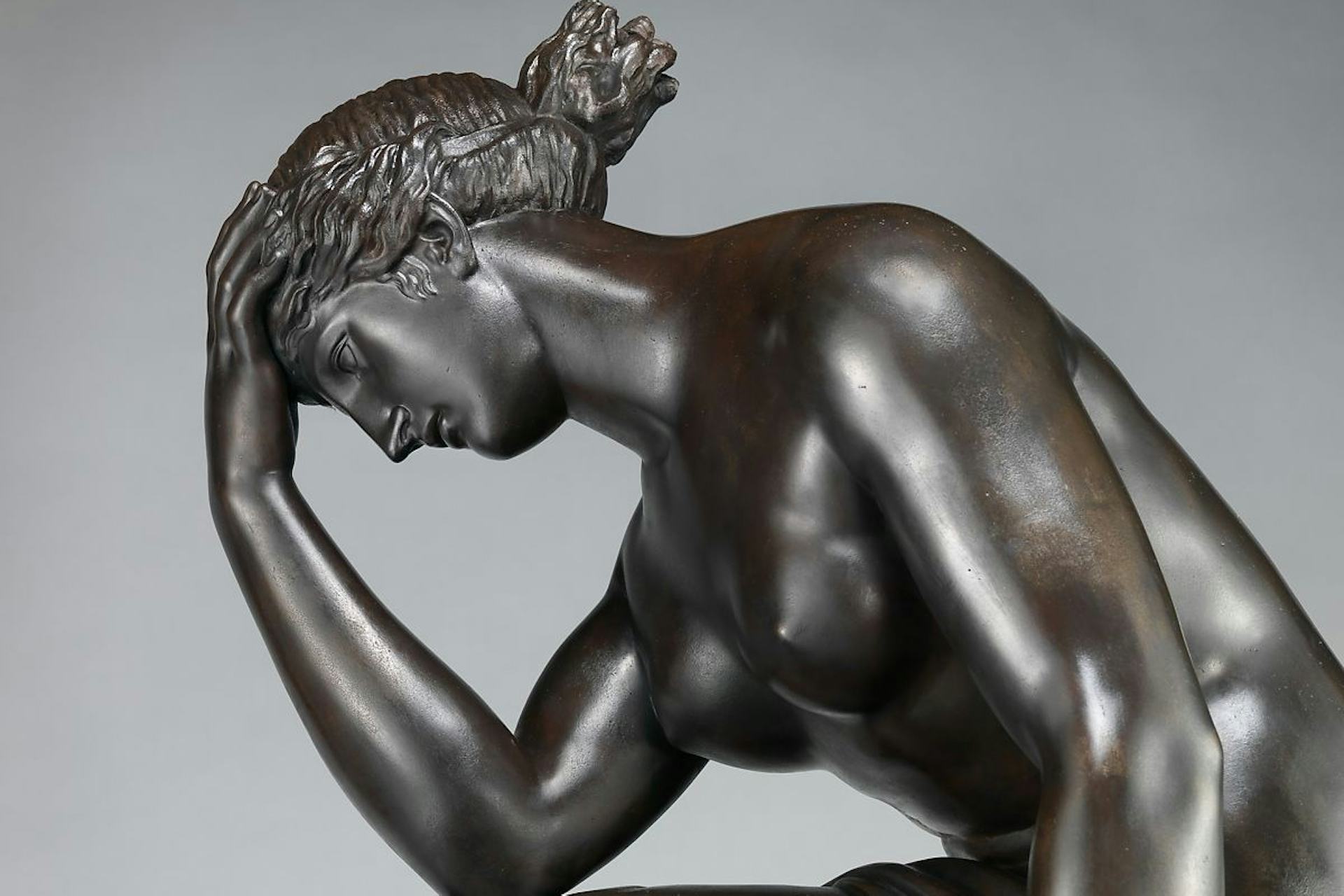
Thetis Transporting Arms for Achilles (detail) by William Theed the Elder (ca. 1804–1812)
The Metropolitan Museum of ArtPublic DomainOverview
Thetis, daughter of Nereus and Doris, was one of the fifty sea nymphs known as the Nereids—probably the most famous and important of them all. She was highly honored by the Olympians, the most powerful gods of the Greek pantheon, and had once saved Zeus himself from an uprising. She married Peleus, a mortal hero who had distinguished himself as one of the Argonauts, and had a son: the warrior Achilles.
Thetis is best known for her role in the mythology of her son Achilles. Reluctant to accept that her son was mortal and had to die, Thetis did everything in her power to stave off his inevitable death—to no avail. Achilles was ultimately killed while fighting in the Trojan War.
Thetis was an important figure in Greek literature, especially Homer’s Iliad. She was also worshipped in some parts of Greece, and some even believe that she was among the most important goddesses of the Greeks in the earliest periods of their history.
Etymology
There is some obscurity surrounding the etymology of the name “Thetis” (Greek Θέτις, translit. Thétis). Both ancient and modern scholars have suggested that the name could be connected to the Greek verb τίθημι (títhēmi), meaning “to establish, set up.”[1] But others have interpreted the name “Thetis” as an early doublet or alternate for “Tethys,” the name of the Titan goddess who married Oceanus and became closely associated with the sea.[2]
Pronunciation
English
Greek
Thetis Θέτις (Thétis) Phonetic
IPA
[THEE-tis] /ˈθi tɪs/
Titles and Epithets
As a daughter of Nereus, Thetis was a “Nereid” (Νηρηΐς, Nērēḯs). Individually, Thetis’ most important epithets were ἀργυρόπεζα (argyrópeza, “silver-footed”) and ἁλοσύδνη (halosýdnē, “sea-born”).
Attributes
Thetis, like her Nereid sisters, was a beautiful sea nymph. She was honored as a goddess and was immortal. Except for a brief period after her marriage to the mortal Peleus—during which she lived in Peleus’ palace in Phthia in northern Greece—Thetis lived with the other Nereids far below the waves, in the luxurious grotto of Nereus.[3]
Thetis, like her father Nereus, was sometimes thought to have had the power to change her shape at will. She tried to use this power to escape Peleus when he came to claim her as his bride, but was unsuccessful.[4]
Several scenes from Thetis’ mythology were popular among ancient artists, especially among vase painters of the sixth and fifth centuries BCE. The most common scenes in ancient art were Thetis’ wrestling match with Peleus, her wedding to Peleus, and her presentation of armor to Achilles.[5]
Family
The father of Thetis was Nereus, a son of Gaea and Pontus who was known for his wisdom; her mother was the Oceanid Doris.[6] She was therefore one of the fifty “Nereids,” the sea nymph daughters of Nereus. According to one source, she also had a brother named Nerites, a handsome companion of Poseidon.[7]
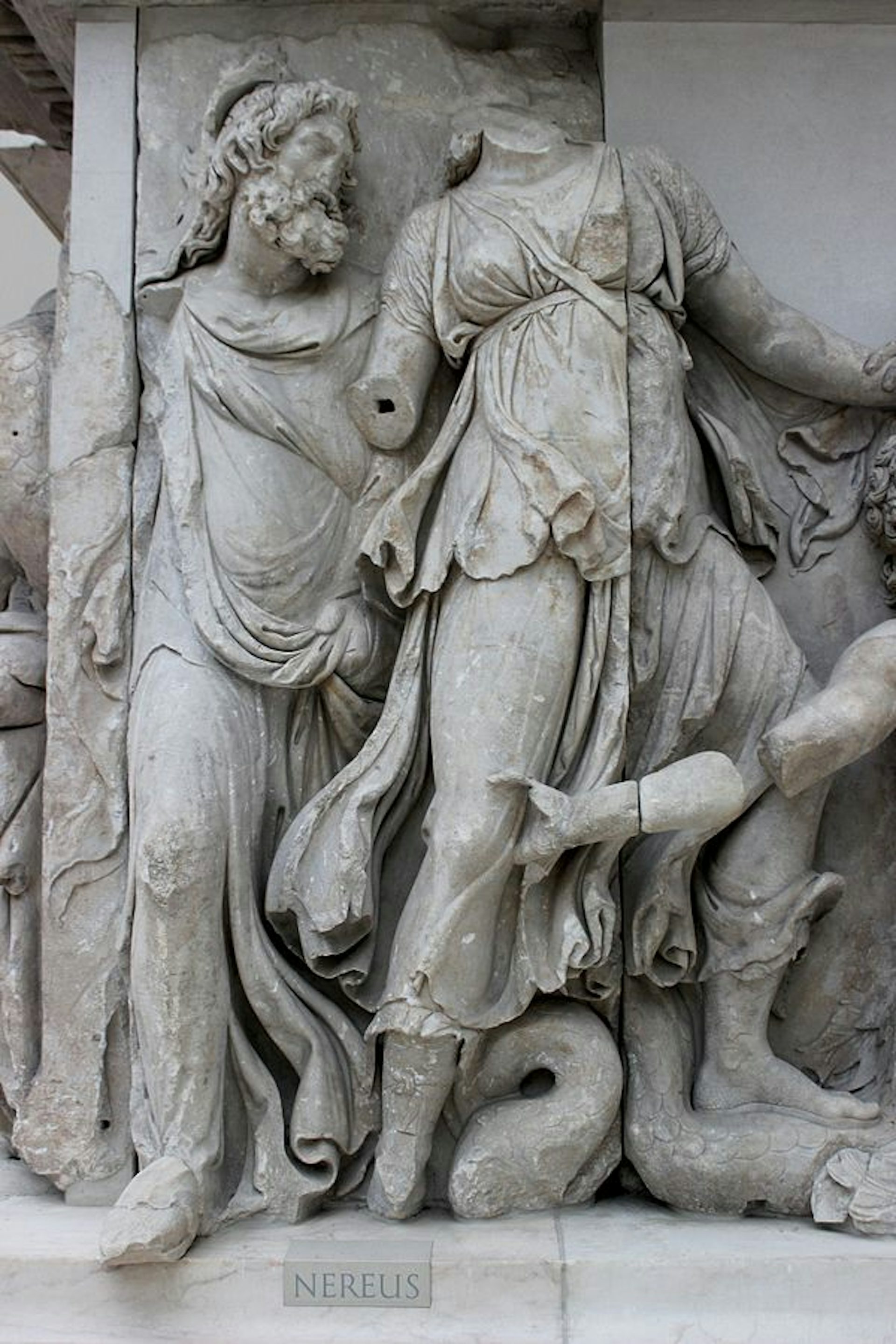
Relief sculpture of Nereus, the father of the Nereids, from the Pergamon Altar (2nd century BCE)
Pergamon Museum, Berlin / Miguel Hermoso CuestaCC BY-SA 4.0But there were other, less familiar traditions about Thetis’ parentage too. In one, Thetis was the daughter of the centaur Chiron, not of Nereus.[8] In another strange account, known only from a fragmentary poem by Alcman, Thetis appears to be one of the first—perhaps even the very first—being to come into existence, together with or just before the abstract personifications Tekmor (“End”) and Poros (“Path”).[9]
Thetis married Peleus, a mortal hero who gained fame as one of the Argonauts, with whom she had a son: Achilles, the greatest hero of the Trojan War.[10]
Mythology
Origins
Thetis was born to the sea gods Nereus and Doris, one of fifty daughters known as the Nereids. She was said to have been raised by Hera, wife of Zeus and queen of the gods.[11] She lived together with her sisters in the depths of the sea, in the palatial grotto of her father Nereus.
Ever since antiquity, Thetis has been considered the most important of the Nereids: ancient sources invoked her “best of the Nereids,”[12] “first of the Nereids,”[13] and so on. Indeed, Thetis had a much more significant role in Greek mythology than any of her sisters (leading some scholars to argue that there was a time when Thetis was a much more central figure in Greek religion).
Thetis and the Gods
In her relationship with the gods, Thetis often took on the role of nurturer or even savior.
In one myth, Thetis kindly nursed Hephaestus back to health after he had been cast out of heaven (there were different versions of who exactly cast Hephaestus out of heaven: it was either Zeus or Hera).[14]
In another, similar myth, Thetis took in the young god Dionysus (or, in some versions, Dionysus’ nurses) when he was fleeing the prosecution of the barbarous Thracian king Lycurgus. As a reward, Dionysus gave Thetis a beautiful urn fashioned by Hephaestus—the urn in which Thetis would someday place the ashes of her son Achilles.[15]
Another time, Thetis saved Zeus himself—the most powerful of the Greek gods. Several of the other Olympians, led by Hera, Poseidon, and Athena, wished to overthrow Zeus and take over his power. While he was sleeping, they bound him in chains. But Thetis summoned Briareus, one of the invincibly strong Hecatoncheires (“Hundred-Handers”) to help Zeus: Briareus broke Zeus’ chains and helped Zeus reassert his dominance.[16]
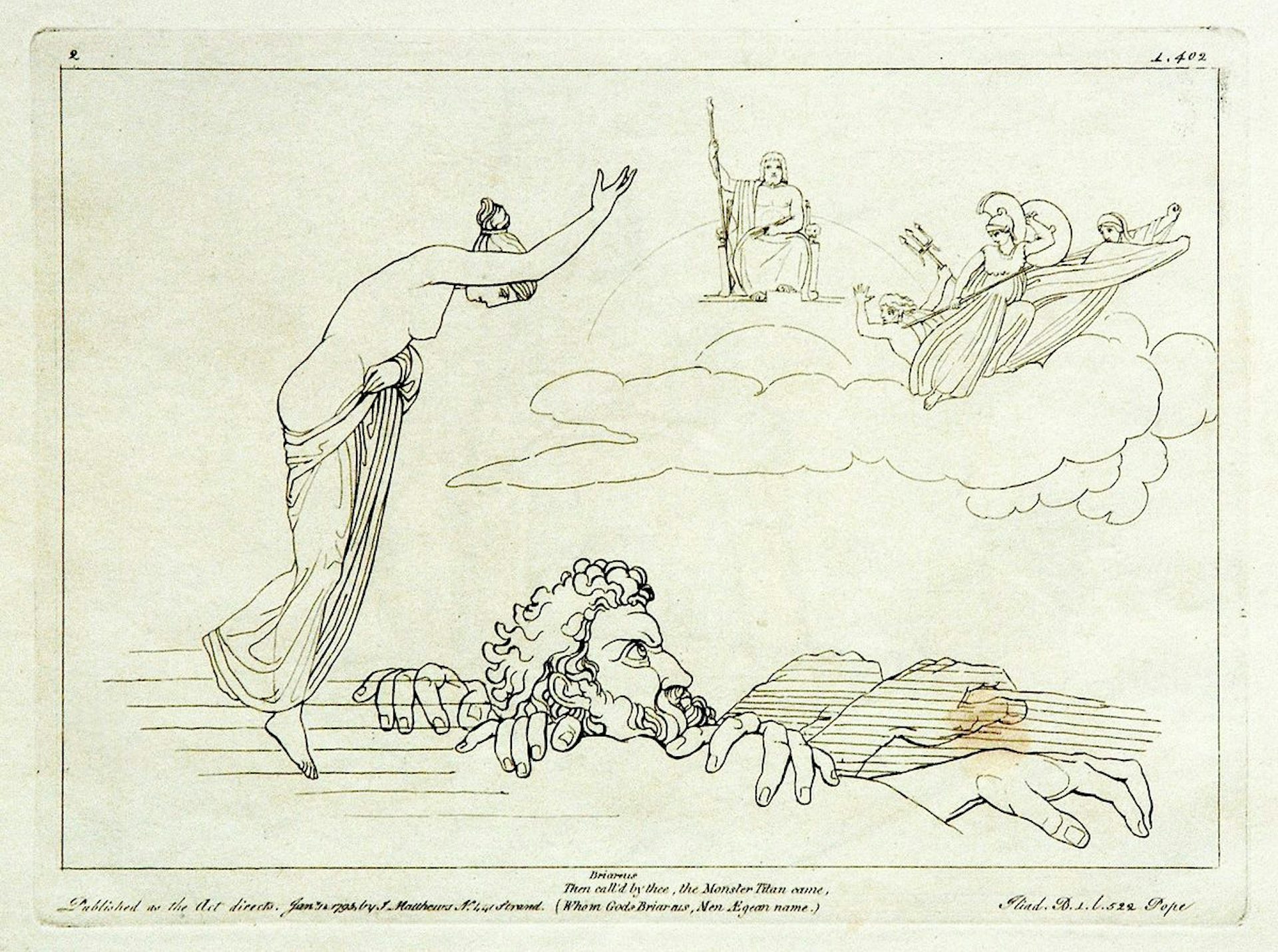
Illustration by John Flaxman (1795) of a myth recounted in Book 1 of Homer's Iliad: Briareus is summoned by Thetis to help Zeus when the other Olympians try to overthrow him
Wikimedia CommonsPublic DomainThetis and Peleus
Though she was a goddess, Thetis was forced to marry a mortal man, the hero Peleus. This myth was known in a few different forms.
Thetis was so beautiful that Zeus (or, in some versions, both Zeus and Poseidon) wanted to sleep with her. In one version, Thetis refused Zeus’ advances because she did not want to offend his jealous wife Hera; to punish her, Zeus vowed that she would marry a mortal.[17] But in another version, it was revealed by an oracle that Thetis was destined to have a son who would be stronger than his father—the last thing a god wanted (when a god had a son who was stronger than they were, that son usually ended up overthrowing their father); to prevent turmoil in heaven, it was decided that Thetis must marry a mortal.[18]
Eventually, Peleus was chosen as a suitable match for Thetis. Though a mortal, Peleus had an impressive lineage—his grandfather was Zeus—and he had a distinguished career as a hero, having sailed with the Argonauts and taken part in the Calydonian Boar Hunt. But before he could marry Thetis, Peleus had to capture her. He found her in a cave and grabbed her. Thetis transformed herself into different shapes in an effort to escape, but Peleus managed to hold on and thus won Thetis as his bride.[19] Thetis and Peleus were married in a lavish wedding, attended by all the great gods and mortals.[20]
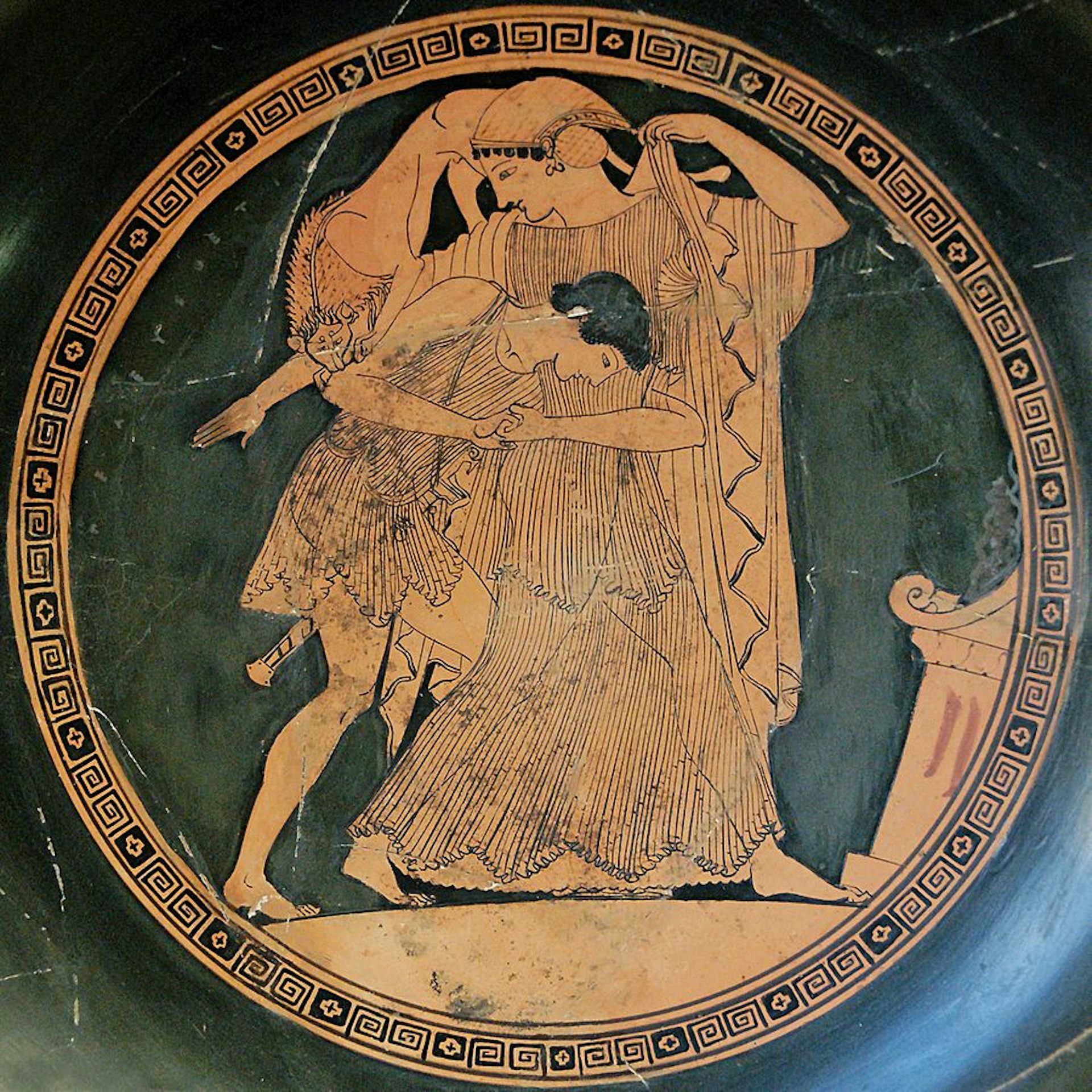
Detail from an Attic red-figure kylix showing Peleus capturing Thetis as she changes shape, attributed to Douris (ca. 490 BCE)
Cabinet des Médailles, Paris / JastrowPublic DomainThere were also other, lesser known traditions about Thetis and Peleus. In one, it was Thetis who pursued Peleus rather than the other way around;[21] in another, Peleus’ wife was not the goddess Thetis but a mortal of the same name;[22] and in another, Peleus was actually married to the mortal Philomela (daughter of the Myrmidon warrior Actor), and his marriage to Thetis was simply a rumor started by the centaur Chiron.[23]
The Birth of Achilles
Thetis could not make peace with the fact that any children she had would be mortals doomed to die; in some traditions, Thetis learned from a prophecy that her son was destined to die in battle.[24]
Thetis went to dramatic lengths to save her son from his inevitable doom. In some traditions, she would throw her children by Peleus into a cauldron of boiling water or fire to test whether they were mortal, killing them all except Achilles, who was saved by Peleus.[25] In other traditions, Thetis tried to make the baby Achilles immortal by either anointing him in ambrosia and putting him into fire[26] or by dipping him into the river Styx.[27]
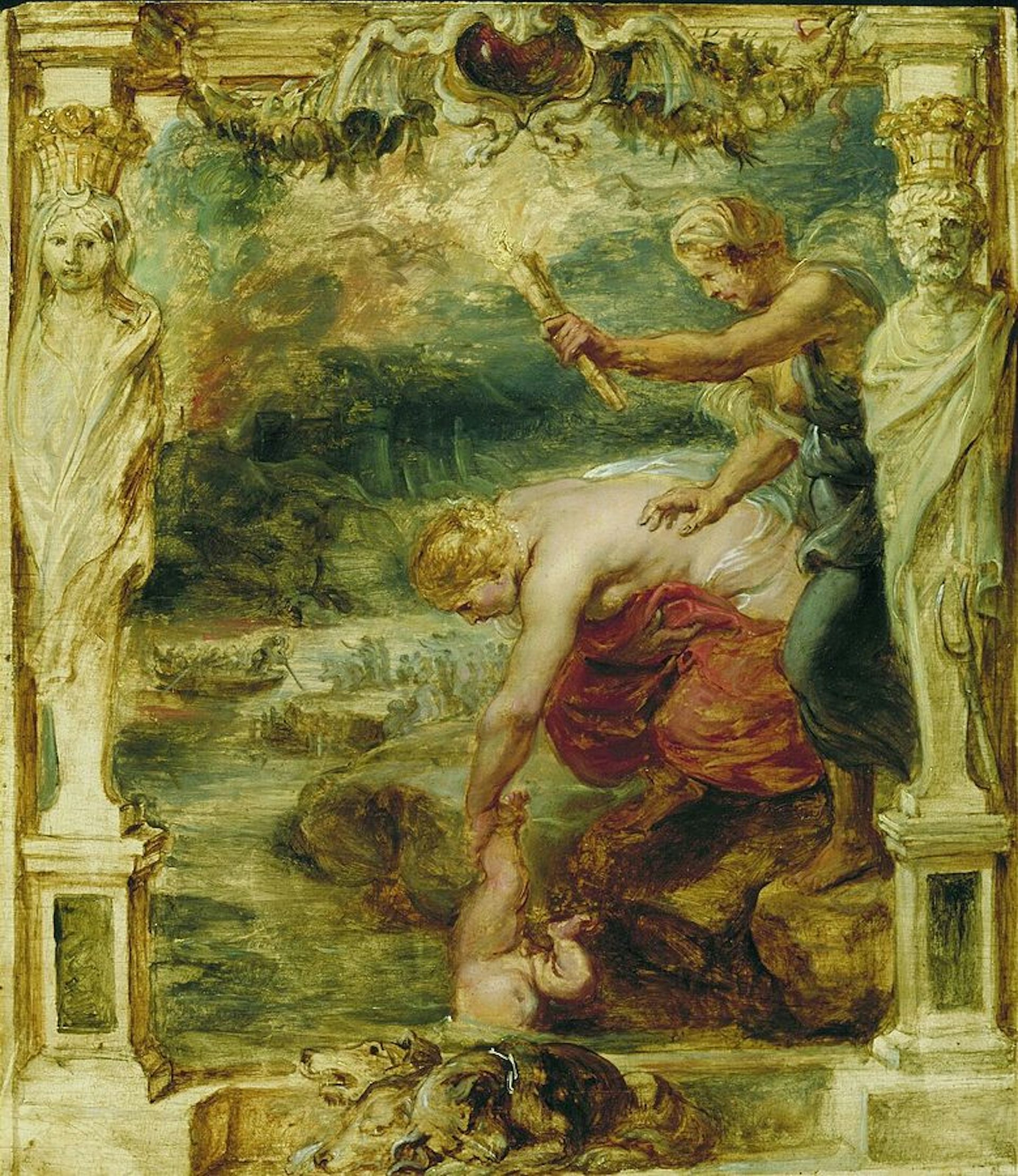
Thetis Dipping the Infant Achilles into the River Styx by Peter Paul Rubens (1630–1635)
Museum Boijmans van Beuningen, RotterdamPublic DomainIn any case, Thetis failed to make her son immortal, either because Peleus walked in on her and caused her to let go of the child before she could complete the process or, alternatively, because the boy remained vulnerable in the part of his body from which Thetis held him—his heel.
In most traditions, Thetis left Peleus soon after the birth of Achilles, unwilling to live as the wife of a mortal or angry at Peleus for interfering with her attempts to make her child immortal.[28] In what became the dominant tradition, Peleus then sent Achilles to be raised and trained by the centaur Chiron.[29]
The Trojan War
When the Greeks were preparing to attack the city of Troy—Helen, the wife of one of the Greek kings, had been carried off by the Trojan prince Paris and the Greeks were bent on getting her back—Thetis wanted desperately to make sure her son Achilles would not fight and die in the war.
In one famous myth, Thetis (or Peleus in some versions) disguised the young Achilles as a girl and sent him to live with the daughters of Lycomedes, the king of the small Aegean island of Skyros. But the clever Greek king Odysseus eventually managed to find Achilles and trick him to come out of hiding. So in the end, Thetis’ plan failed and Achilles joined the Greek army in their war against Troy.[30]
Thetis continued protecting and helping Achilles throughout the Trojan War, even though she knew he was doomed to die. When Agamemnon, the commander-in-chief of the Greek army, insulted Achilles in the ninth year of the war, Achilles vowed to leave the fighting. He asked Thetis to ask Zeus to let the Trojans get the better of the Greeks for a while so that the Greeks would suffer for not giving him the honor he deserved. Thetis did as Achilles asked and Zeus agreed to help.[31]
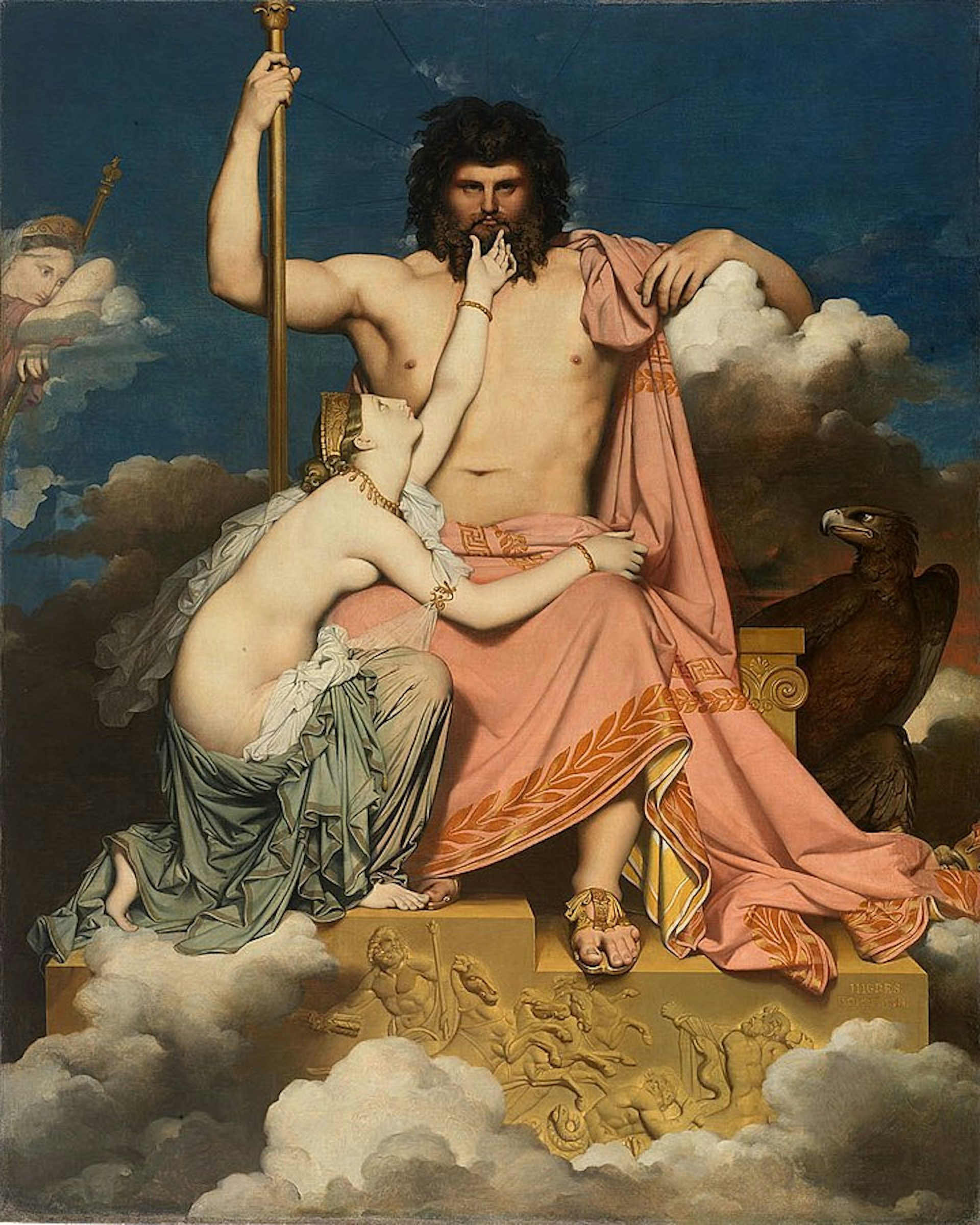
Jupiter and Thetis by Jean-Auguste-Dominique Ingres (1811)
Musée Granet, AixPublic DomainSoon afterwards, Achilles' best friend Patroclus went into battle wearing Achilles’ armor and was killed by Hector, the crown prince of Troy and the greatest of the Trojan heroes. Achilles was consumed by grief. Thetis, accompanied by the other Nereids, came to comfort Achilles and mourn with him. She revealed to Achilles that if he tried to avenge Patroclus by fighting Hector, his fate would be sealed: he would die in battle. But when Achilles made it clear that he would not change his mind about returning to the fighting, Thetis promised she would bring Achilles new armor and weapons forged by Hephaestus.[32]
After Thetis brought Achilles his new suit of armor, Achilles marched into battle and killed Hector.[33] Achilles then dishonored Hector’s body for days, until Thetis warned him that the gods had commanded him to return the body to Troy for a proper funeral; Priam, Hector’s father and the king of Troy, came into the camp for the body and Achilles turned it over to him.[34]
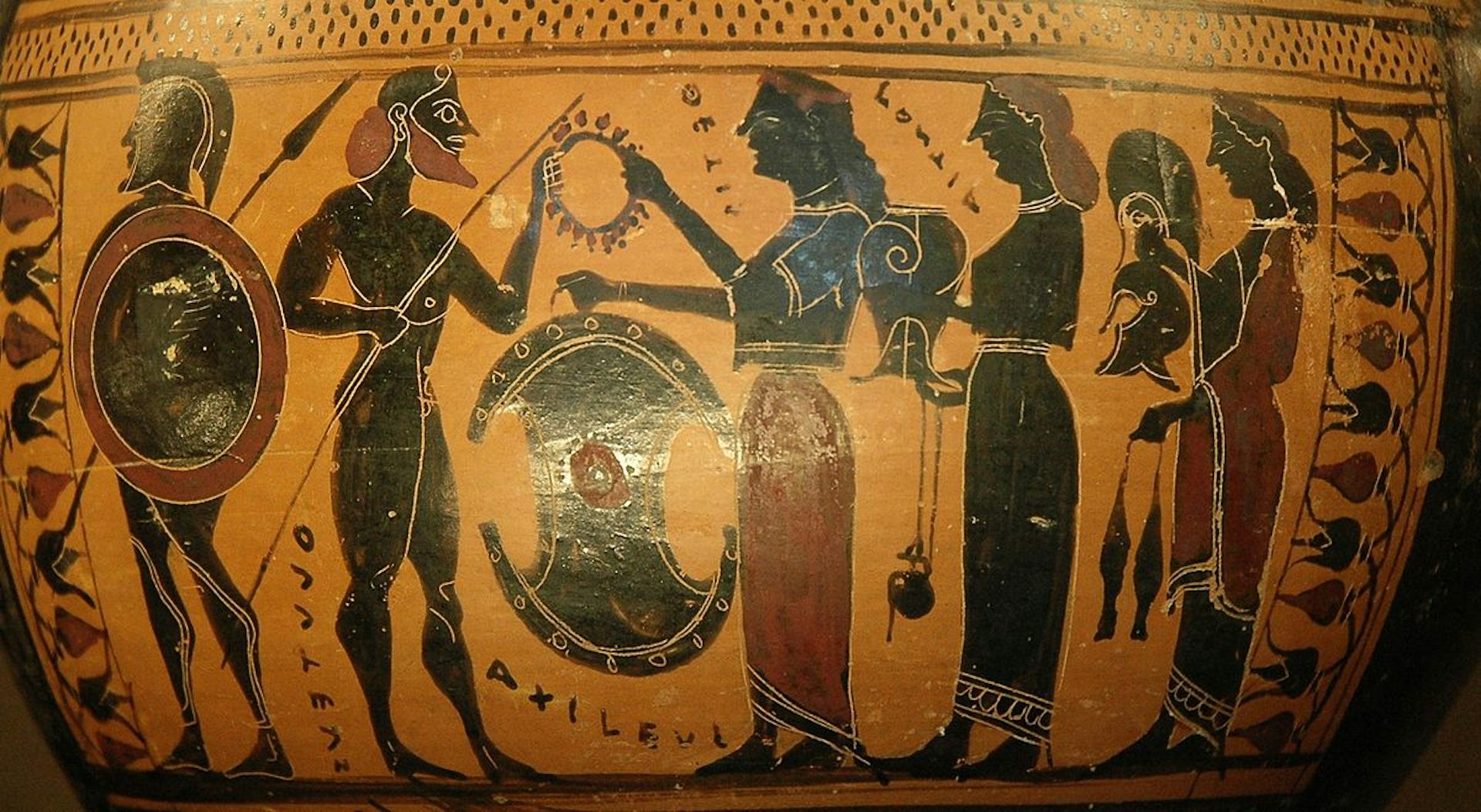
Detail from an Attic black-figure hydria showing Thetis and her attendants (right) presenting Achilles (left) with armor (ca. 575–550 BCE)
Louvre Museum, Paris / JastrowPublic DomainThetis continued to help Achilles after the death of Hector. For example, she interceded with Zeus on his behalf when he fought the Ethiopian hero Memnon, who had come to help the Trojans.[35] But soon Achilles fell in battle, just as had been predicted. In the familiar tradition, he was shot in the heel with an arrow shot by Hector’s brother Paris and guided by the god Apollo himself. Thetis and the other Nereids came to help bury and mourn Achilles.[36]
In some traditions, Thetis ultimately had her way and managed to make Achilles immortal, in a sense. After the hero was killed, she took him to the Isles of the Blessed, sometimes also called Leuce or Elysium. There, Achilles lived in eternal bliss with other great heroes and demigods. Some said that there he married the beautiful witch Medea or even Helen.[37]
Other Myths
Though most of Thetis’ mythology surrounded her role as wife of Peleus and mother of Achilles, there were other myths about her too.
In one myth, Thetis and the Nereids helped the Argonauts sail through the Planctae, the “Wandering Rocks,” which crushed most ships that passed through them.[38]
Another myth, found in Ovid’s Metamorphoses, involved Thetis’ husband Peleus. Psamathe—a Nereid and thus one of Thetis’ sisters—wanted to punish Peleus for killing her son Phocus. She sent a monstrous wolf to attack Peleus’ lands and devour his herds. Peleus begged Thetis for help, and Thetis managed to convince her sister to forgive Peleus.[39]
Other myths involved Thetis’ role in the homecoming of the Greeks who had fought at Troy. After the Greeks sacked Troy, Thetis warned Neoptolemus, her grandson, to sacrifice to the gods before sailing home. He and those who stayed with him were able to get home safely, but those who left without sacrificing suffered terrible storms.[40] Some were even shipwrecked and killed—one of these casualties, the hero Ajax the Lesser, was said to have been buried by Thetis herself.[41]
In one strange, little known tradition, Thetis blamed the death of her son Achilles on Helen, who helped cause the Trojan War by running off with the Trojan Paris. Thetis punished Helen—according to Ptolemy Hephaestion at least—by transforming her into a seal after the war was over.[42]
Another obscure myth—also found in the work of Ptolemy Hephaestion—told of how the witch Medea challenged Thetis to a beauty contest. When the Cretan hero Idomeneus judged the contest in Thetis’ favor, Medea was so enraged that she cursed Idomeneus: claiming that his judgment was false, she made him incapable of ever telling the truth.[43]
Worship
Thetis was worshiped in some parts of Greece. There is evidence that she had cults in Sparta,[44] Thessaly,[45] and Pharsalus.[46] Her Spartan cult seems to have been particularly important: it was centered around an archaic temple called a Thetideion that contained a wooden cult image of the goddess said to be even more ancient than the temple itself.
Though Thetis was a minor goddess by the Classical Period of Greek history (ca. 490–323 BCE), it is possible that she was a much more important deity before then. For example, she plays a remarkably important role in the Iliad, which was put into writing around 750 BCE. Even more intriguing is a fragment from a poem by Alcman, who lived in Sparta in the seventh century BCE: here, Thetis appears to be named as the first being to come into existence and as one of the creators of the cosmos.[47]
Pop Culture
Thetis continues to appear in some modern adaptations of Greek myths, especially the myths of the Trojan War. Thetis has been a character in films such as Clash of the Titans (1981) and Troy (2004). In the latter, she is reimagined as a priestess rather than as an actual goddess.
Thetis also features in Madeline Miller’s 2011 novel, The Song of Achilles. She is portrayed as a cold character who has a strained relationship with her son Achilles and who strongly disapproves of Achilles friend (and lover) Patroclus.